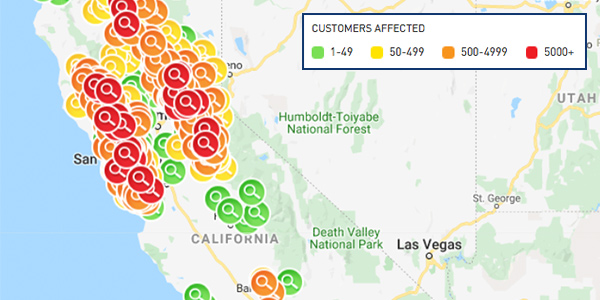By Hudson Sangree
Pacific Gas and Electric restored power to 738,000 customers across central and Northern California over the weekend after its public safety power shutoffs (PSPS) and failed communications prompted a backlash from the public, state regulators and elected officials.
California Gov. Gavin Newsom backtracked on his earlier statements that the shutoffs were an appropriate means to prevent wildfires and said during a news conference last week that PG&E’s neglect of its power lines had led to the massive intentional blackout of more than 2 million residents.
“This is not, from my perspective, a climate change story as much as a story about greed and mismanagement over the course of decades,” the governor said Thursday during a press conference at the state’s Office of Emergency Services near Sacramento.
Responding to criticism in his own news conference, PG&E Corp. CEO Bill Johnson acknowledged mistakes. The utility’s website had crashed, its phone lines were overloaded and its shutoff maps were inconsistent if not incorrect, he said.
“To put it simply, we were not adequately prepared to support the operational event,” Johnson said.
The CEO said the utility decided to shut off power in 34 counties based on its weather predictions but did not have the “granularity” needed to limit shutoffs to areas where they were most needed. He vowed the company would do better next time.
PG&E instituted the blackouts as part of its effort to prevent the type of deadly and destructive fires that its equipment sparked during similar windy fall weather conditions in 2017/18. Those fires included the Camp Fire, which killed 86 people and destroyed much of the town of Paradise in November 2018.
At least one fire flared up last week near the San Francisco Bay Area community of Moraga but was quickly contained. No major wildfires occurred in Northern California during the blackout.
CPUC Responds
The PSPS was included in the wildfire mitigation plan PG&E filed with the California Public Utilities Commission earlier this year. The commission approved PG&E’s plan in May. (See California Regulators OK Utility Wildfire Plans.)
That did not stop the CPUC from slamming PG&E at its voting meeting Thursday in San Francisco. In that meeting, new commission President Marybel Batjer said PG&E’s actions were unsupportable. (See Calif. Regulators Bash PG&E Power Shutoffs.)
“The management and the response of the company, PG&E, to the [PSPS] have been absolutely unacceptable,” Batjer said. “The impacts to individual communities, to individual people, to the commerce of our state, to the safety of our people has been less than exemplary.
“This cannot be the new normal,” she said. “We can’t accept it as the new normal, and we won’t.”
She called for a review of the public policies that led to by far the largest blackout to prevent wildfires ever to hit the state.
Commissioner Genevieve Shiroma suggested the massive shutoff wouldn’t have been necessary if PG&E had maintained and upgraded its infrastructure to prevent fires.
“The sheer magnitude [of PG&E’s PSPS] is indicative of the condition of the utility in terms of what we call the hardening — that means the condition of the poles, the lines, the wires, the transformers, the transmission lines — and the maintenance, or lack thereof, of the system and the vegetation management,” Shiroma said.
The CPUC’s deputy executive director for safety, Elizaveta Malashenko, told commission that the shutoffs affected about 2,400 miles of transmission lines and 24,000 miles of distribution lines. CAISO had been working to contain the shutoffs so that they didn’t spill over into neighboring areas, she said.
The state had tried to help PG&E keep its website and servers working, soliciting help from the likes of Microsoft and other tech companies, she said.
Southern California Response
Several wildfires did occur in Southern California as hot dry Santa Ana winds blew late last week. The largest of the blazes was the Saddleridge Fire, which burned nearly 8,000 acres above the San Fernando Valley, forcing widespread evacuations.
Residents told several news outlets they’d seen flames beneath a Southern California Edison transmission tower Thursday night as the fire started, but those reports have yet to be confirmed by fire officials or SCE.
SCE had shut off power to thousands of its customers in the greater Los Angeles area to prevent fires, but a spokeswoman told the Los Angeles Times that the transmission line in question had not been de-energized.
All but four SCE customers had power as of Monday, the company said on its website.
Firefighters continued to make progress on the Saddleridge Fire, which was about 43% contained as of Monday morning, according to the California Department of Forestry and Fire Protection. Cal Fire said the blaze had caused at least one death.





